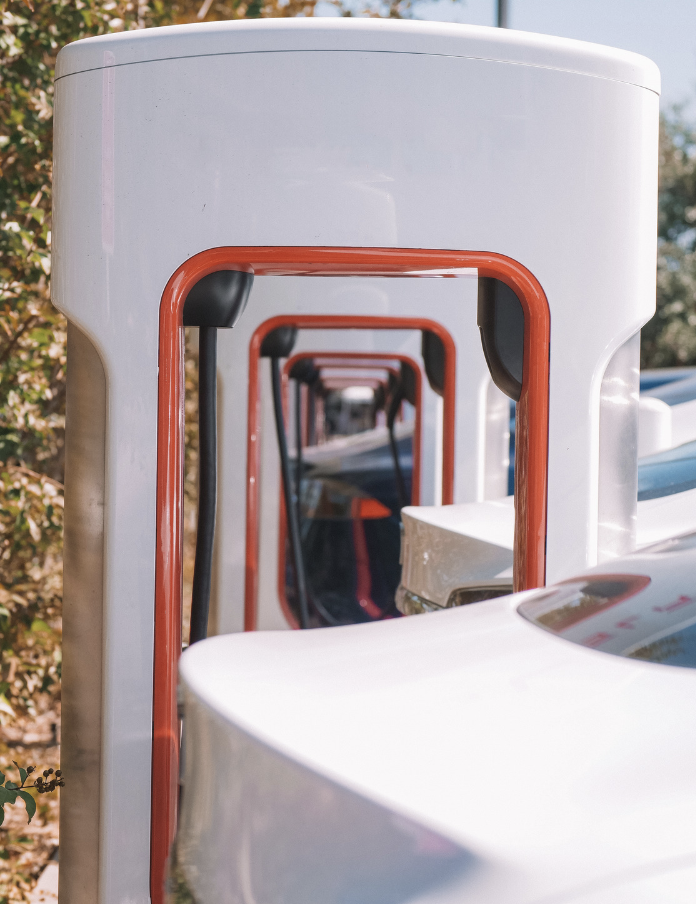Included in this group are the sleek and black payment terminal and charging port. Poles cost about €3,000 to €4,000 per, not including installation
This is more expensive than other street chargers, and CityCharge CEO Heimen Visser is the first to apologize for it. But he thinks you can charge your phone and light up your path at the same time, so it’s really a 2-for-1 bargain.
Lamppost charging allows for the possibility of a deluge of slow chargers covering villages and cities. Although 22 kW is the midpoint of the speed range, and the devices from CityCharge and SimpleCharge can achieve it, rapid chargers are faster than slow overnight chargers.
Additionally, they are accessible 24/7.
Mr. Markots claims that places with older infrastructure are more prone to charging at night with the lights switched on.
Electric car charging capabilities have been integrated into the lampposts and bollards designed by Ubitricity, a Shell company. Its bollards and lampposts typically charge at a rate of 5 kW.
Some EV charging companies have gone to great lengths to make their stations unobtrusive or even appealing
One example is portable chargers that can be lowered into the ground while not in use; these are examples of underground chargers.
Scottish company Trojan Energy’s chargers lie flush with the sidewalk and resemble little manhole covers. They would probably go unnoticed by people going about their daily lives.
The company has spoken with disability advocacy organizations to guarantee the chargers are safe for those with impairments.
North London councils and Trojan Energy have been working together to put six to fifteen charging stations in prime places, mostly along residential streets without driveways, to make it illegal to park vehicles on the street at all. “Our solution is ideal for row upon row of terraced houses,” says Sarah Clements, Trojan Energy’s head of business development.
Customers are required to use a 2.7-kilogram specialized attachment known as a lance in order to charge their gadgets at Trojan Energy stations. With the help of the lance, automatic billing is achieved. Thus, the convenience of plug-and-play charging might compensate for the potential inconvenience of carrying an extra device.
Restoring the pavement, opening the route, and performing the civil and electrical work all require time. The typical installation time for a hub is two weeks.
Concurrently, BT Group plans to convert old green street cabinets into charging hubs
Telephone and internet wires have traditionally been stored in metal cabinets, but many of these boxes are getting on in years.
With the potential to convert up to 60,000 cabinets, BT intends to soon begin a trial program in Scotland.
A new method for conserving space that prioritizes adaptability has replaced the use of permanent places on existing pavements. Mobile chargers are being trialed in places like airport parking lots since it would be cumbersome for drivers to leave their vehicles plugged into chargers for weeks at a time while they are away.
The Bolt-ee is a very quick charger that was created by a company in the United Kingdom named Nyobolt. Its 300 kW of direct current output can fully recharge a car in only a few minutes. Sai Shivareddy, co-founder and CEO of Nyobolt, has said that this portable device is quite heavy and around the size of a suitcase.
A semi-autonomous Bolt-ee model that can be mounted on wheels may rove to cars that need an immediate power boost
Attaining total autonomy would be challenging. As of right now, according to Bolt-ee, a human operator is still needed to plug the connection into the vehicle. “To get an arm that goes into the charge point location is a big challenge,” Mr. Shivareddy continues.
Hyundai has developed an autonomous charging robot that uses a 3D camera and an AI system to put the charging cable into the socket. At least for the time being, however, the robot’s arm may move about freely while the base stays still.
In general, drivers would prefer a mobile charger since it would save them space and they wouldn’t have to fight for parking near a fixed charger.
Mobile technology, according to Mr. Shivareddy, has other potential uses beyond aiding rescue operations, one of which being the elimination of the need to pull vehicles simply because their batteries expire.
With their correct deployment, mobile chargers have the potential to rectify the present distribution of chargers, which is unduly concentrated along highways and in wealthy metropolitan regions.
The Bolt-ee has an impressive battery life of over 10,000 cycles, as reported by Nyobolt. Mr. Shivareddy asserts that Bolt-ee chargers are more cost-effective per kilowatt-hour compared to their competitors.
A professor of transportation electrification and smart grids at Cardiff University’s School of Engineering, Liana Cipcigan, has suggested that completely portable charging might help those with disabilities
Mobile charging robots may not be financially viable right now, says Professor Cipcigan.
Portable chargers can raise concerns about their safety. “Moving these batteries could be a hazard,” adds Prof. Cipcigan.
In response to Mr. Shivareddy’s concern about fire safety, Nyobolt has built Bolt-ee to be very efficient, with little waste heat, according to Mr. Shivareddy.
You will need more solutions in order to meet the increasing demand. There should be more than just lampposts and bollards. One possible outcome is that the market for mobile robotic charging will remain niche. As a further caveat, pavement-embedded chargers aren’t the best choice for areas like Los Angeles, where the pavement is often thin or flaking.
But these innovative, space-saving ideas will help speed up the electric car revolution when they’re put together.
Millennials and smaller enterprises “could make an interesting impact on this very complex landscape,” asserts Professor Cipcigan, who believes that there is much opportunity for innovation in the electric car charging market.



